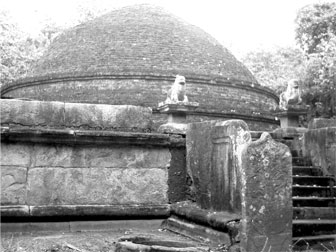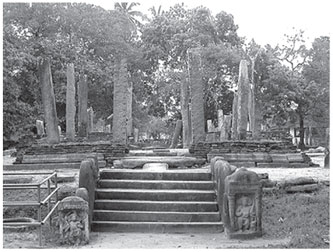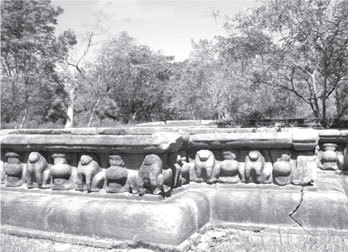|
Magul Maha Vihara:
Venue of Kavantissa’s royal wedding


The Stupa Moonstone |

Ruins of Magul Maha Vihara |
It was the time when King Kawanthissa ruled the Kingdom of Ruhuna.
One day, the king’s men saw an object floating on the sea. It glistened
under the rays of the sun and came towards the shore. When it got
closer, they were surprised to see that it was a golden canoe carrying a
beautiful princess. They informed the king about this, but
unfortunately, the boat had gone past them when the king reached the
beach.
“Where is the princess?” he inquired. By then the boat had been swept
away by a strong current towards a village known as Komarigama (coined
from the words ‘Ko Kumari’) in Arugam Bay. The canoe had not been able
to anchor at Kirinde due to its rocky environment. King Kawanthissa’s
people informed him that she was known as Princess Devi, and was the
daughter of King Kelanithissa of ‘Maya Rata’. She had been offered as a
sacrifice to appease the sea-gods, as the sea waters had threatened to
drown villagers.
It was known to be the first tsunami which hit Sri Lanka. Somehow,
King Kawanthissa met the princess who was eventually saved, and married
her, in keeping with the traditional customs. Then, she became Queen
Vihara Maha Devi. The marriage between King Kawanthissa and Princess
Devi is believed to have taken place where Magul Maha Vihara stands. It
is situated in Lahugala along Wellawaya-Moneragala Road, off
Siyambalanduwa. It is also known as Ruhunu Maha Vihara.
According to historical sources, Princess Devi’s canoe had been
washed ashore at Arugam Bay, and not at Kirinde, as most people believe.
The entire vihara complex had been known to cover an extent of around
10,000 acres, where the ruins of a palace, moonstone, monastery,
bo-maluwa, stupas and ponds are located. The history of the temple dates
back to the time of King Dathusena, who ruled Anuradhapura from 516 AD
to 526 AD. According to a pillar inscription at the premises, the
founder of the vihara is King Dathusena. The language and script have
been dated to the 14th century. A stone wall, which is three to four
feet in height, gives it the appearance of a fortress, built to protect
the premises from an outside attack. At the entrance, there is a
moonstone with a unique carving. A row of elephants and creepers
followed by a row of lotuses is a unique feature of the moonstone. This
is believed to be the only one of its kind in Sri Lanka. There are rock
pillars as well, which are similar to those at Lovamaha Prasada in
Anuradhapura. Ruins of a dagoba, which is 30 feet in height, are also
found at the site. There are three rows of steps leading to the dagoba
on three sides, and on the left is the Bodhigara and also a rock
inscription protected by an iron railing. The magul poruwa of the royal
couple is still found at the temple. The wedding ceremony is not the
only fascinating aspect of the Magul Maha Vihara. There are legends that
make the temple more attractive. The bhikkhu who lives at the temple
explained how they found the well used today. “Before we found the well,
the villagers and we had to walk around 4km to get water”, said the
bhikkhu. One day, when the Viharadhipathi was asleep, someone had
appeared in a dream and told him, “There’s a well in this place, dig it
up”. So, the villagers and the bhikkhus had started digging the place
mentioned in the dream. At last, they found a stone. They didn’t even
have to break it. They just pulled it and kept it aside. There was
crystal clear water in a well-built well. “The villagers were
overjoyed,” said the bhikkhu.
During the Chola invasion the villagers had closed the well and run
for safety. The beauty of the ancient sculptures found at Lahugala shows
the skill of the sculptors of Anuradhapura. Their work is essentially
Sri Lankan; although they had been influenced by Indian sculpture.

The unique moonstone |

Ruins of Magul Maha Vihara |
|

